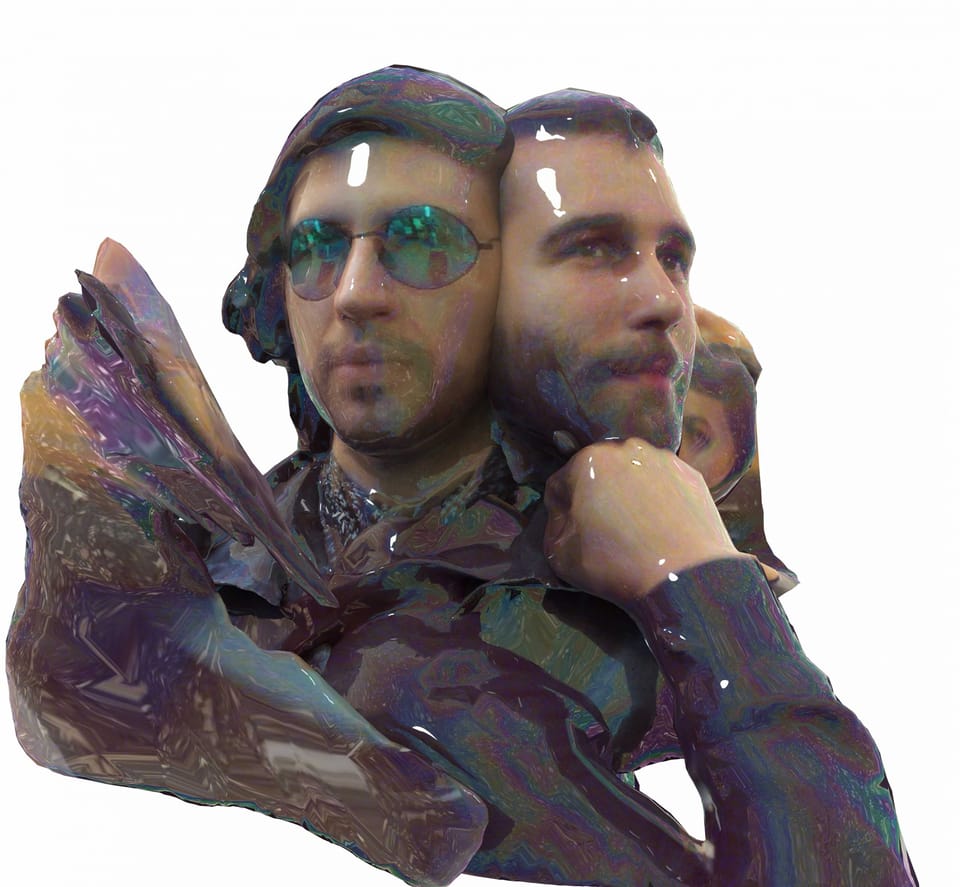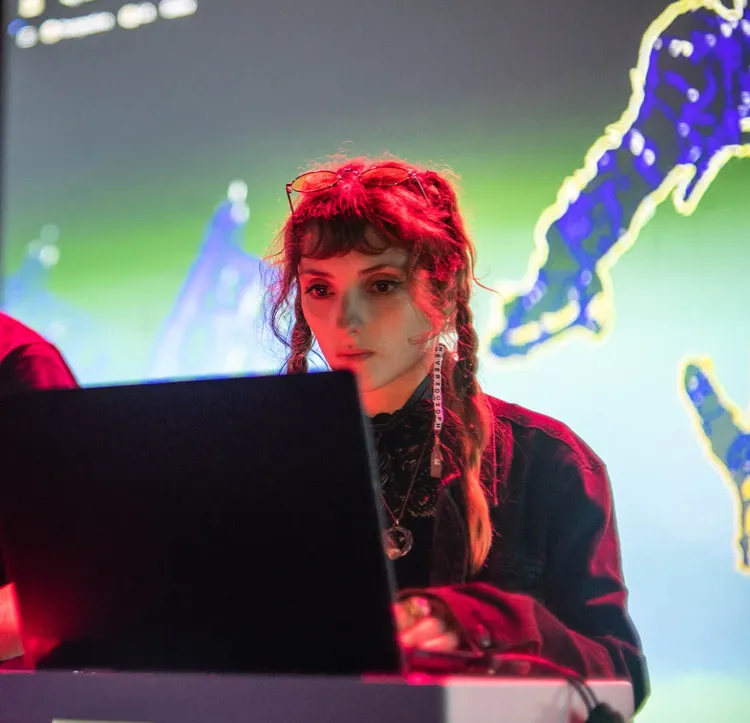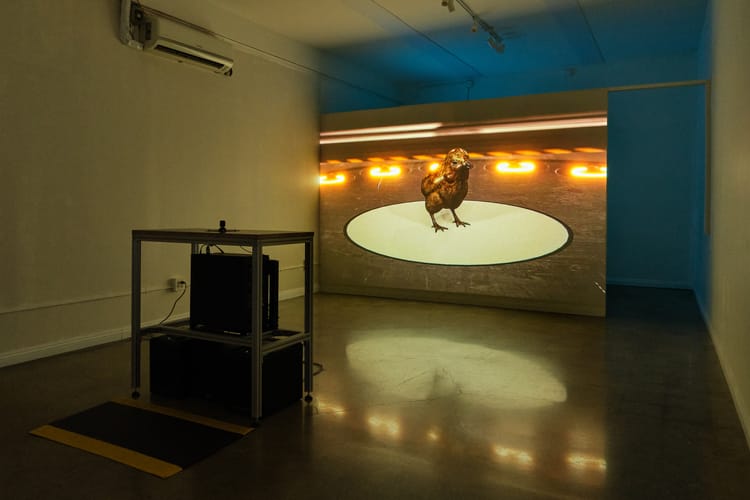Will Robertson and Alfredo Salazar-Caro: Transcending the confines of a museum

After connecting at art school almost a decade ago, New Media artists Alfredo Salazar-Caro and Will Robertson have teamed up to dream up an ongoing project that’s at once a virtual architectural feat, curatorial platform, and artwork in itself: The Digital Museum of Digital Art, or DiMoDA for short. With Alfredo creative-directing, Will building the technical world, and a host of virtual reality artists and architects contributing, DiMoDA has become one of the world’s premiere online digital gallery spaces. DiMoDA 4.0, the project’s fourth iteration, takes place in a spiral-shaped building in a post-apocalyptic, Brooklyn. It is set to be released in late 2021.
Here, we speak with Alfredo and Will about their collaboration across technical and conceptual duties, working with artists like Jacolby Satterwhite, and how a digital museum can operate as a form of institutional critique.


To start, could you both talk about your first creative impulses?
Will: I grew up in St. Louis, Missouri. I was three when I started spending a lot of time at my grandparents’ house—they had a piano, and that was the go-to for me. I was very close with my grandparents, and the piano was my first introduction to music.
I went to an all-boys Jesuit high school—being a smaller school, we didn’t have enough people in-band to fill out every single part for every piece that we played in concerts. So I would bounce around with different parts. I’d be on a trumpet for one part for one song, and then I’d move over to French horn or percussion. For a long time, music was my sole creative outlet. I was originally not in art school, either. I was studying physics and pre-med and really hated that. The only classes I really enjoyed were photography, film, theory, and writing. I decided that the School of the Art Institute of Chicago was the place I wanted to be. I transferred, which was really the start of my focused drive into creative arts as a career and a passion.

Alfredo: I grew up in Mexico City until I was 13 and then did high school in Texas. I drew Power Rangers in kindergarten, and I used to exchange drawings to little friends for juice, candy, or whatever they brought with them. I traded my art for people’s lunch at a young age.
I had a metal band at 17 through 19. Then the band broke up, and I was like, “I’m going to never depend on a band again.” I decided to be individually creative. Like Will, I also went into college to study to be a doctor. I was into neuroscience. That was my jam. I still love the topic, but art classes felt a lot cooler. The things that I was supposed to be focused on felt like a fucking drag.
When I started art, it was all about sculpture and installation. I went to the School of the Art Institute of Chicago, where I met Will, and I also was introduced to media arts. We were both integrated into the Chicago new media scene right away, specifically through something called the Glitch Festival in 2011.
At this festival, people would destroy computers for fun. Will and I, in particular, were enthusiastic about video game engines being utilized for live audiovisuals and glitching. People were approaching it in different ways, but Will and I started coming up with this idea through that process.

Will: It was a Unity online glitch gallery, and the idea was to use the Unity engine to put together a gallery space and then put it up on web GL and host it online. It started out as a very similar idea to some of the other online galleries that are now out hosting sculpture or video or performance or whatever. It evolved from there.
Alfredo: It happened to be at the same time that VR started coming out only for developers. There had been VR headsets, but you had to be part of either NASA or some university research lab or MIT or whatever, to be able to play around with virtual reality. And at a certain point, people could just get it to make stuff.” The very, very early Oculus. We decided the most native way to experience the work that we’re interested in is not just looking at it on the screen but being inside of that work because these are words that we’re creating. We decided that we wanted to work in virtual reality. That’s where DiMoDA was born.



DiMoDA is a digital museum, a curatorial platform. In the past, you’ve called it a piece of institutional critique or an art piece in itself.
Will: It really started for us to be a part of that Chicago New Media scene and really have a hard time finding institutional support for the work we were doing and our contemporaries were doing. It’s becoming more and more accepted as art canon these days, which is great because it’s a lot faster than a whole lot of other things that have been accepted into the art community, but the fine art institutional fine art community. One of the initial conversations we had about forming DiMoDA was that we would not be rejected by these institutions. If we aren’t accepted into the things they’re curating, we’ll create our own institution.
Alfredo: What was happening in the Chicago scene at the time was some of the most fascinating work that was happening, frankly, all over the world. Glitch was composed of people that were coming together from the internet. So our online communities were worldwide. So for us, this was cutting-edge work, but the institutions don’t give a shit.”
We realized institutions wouldn’t give us space. We’re going to create the space.” We reached out to a group of people that were all part of that Glitch community to start this project with us, and people were like, “Cool idea.” Nobody followed up except for Will and me.


Alfredo: On institutional critique, we were poking fun at the image and aesthetic of the art museum. So we decided to use the same lettering as MoMA. In the early version of the DiMoDA, our mission statement and stuff were literally just copy-pasted from MoMA, The Whitney, and all those museums and just replacing contemporary art with computer art or glitch. Initially, it was a total reflection of that. It’s interesting how it’s evolved because now I wouldn’t exactly call it an institution of its own, but it still emulates that, and we now work with all these institutions. It’s funny how that happens.
DiMoDA is a work of art in itself, it’s always been an art project. We decided to name our project the Digital Museum of Digital Art because, for one, we wanted to give it that aura of a museum. The power, because ultimately all these places, whether you call them museums or federal buildings or capitals, or universities, they’re just buildings until you give them these titles of what they mean and they represent socially. We wanted the word “museum” to give DiMoDA that power just by concept versus calling it a gallery.


I’m sure the creative design process has changed over the four iterations of DiMoDA. Generally, what is the process of designing and building the space and positioning the pieces inside it?
Will: I worked for the Art Institute of Chicago for five years in the Digital Department. DiMoDA was ongoing simultaneously. At the Art Institute, the role I had there was a Technical Integration Producer. I oversaw all of the public-facing digital media in the museum. So, everything from digital signage, screens all across the galleries and lobby areas to all of the interactive installations, permanent ones, temporary exhibitions, in the family areas as well, up to the mobile applications.
I oversaw the day-to-day operations of the technical integration and design of those into the museum system. The mobile app, for example, is tied directly into the collections database. So in the content management system, if they want to pull in a new work into the app, they pull the records directly from that database so that we always know these are the right images. These are the notes from the curator that will be put into the description. There’s one source of truth. And from that experience, I learned a lot about building things for long-term maintenance, trying to reduce complexity in systems where you can use them to easily maintain them as an individual.


Will: The Art Institute of Chicago has many very talented people working there; the wonderful audiovisual team that helped set up screens, projectors, equipment. I definitely want to give those people credit. Still, museums don’t have the same sort of infrastructure as Google that can just throw engineers at problems, and you can have these crazy complex systems—where, if something goes wrong, you’ve got five, 10 people who can go and tackle it. Being a technical one-man band at DiMoDA and I oversee all of the integrations of the artist’s work and tying all of the pieces together. What I do in my role is taking on the technical backend side a lot of the time of how we should put the whole system together to maintain it. As an institution, we want to keep these pieces up-to-date and available, and accessible in perpetuity. I’m really taking on a very technical backend role, and then Alfredo is taking on more of a visual and conceptual design role.


You’ve worked with a line-up of amazing artists over he years. Are there any memorable moments from those collaborations that have helped you understand the power of interactive media, or were just really exciting in how that DiMoDA maybe helped the artists understand the power of interactive media?
Will: The first exhibition was the most experimental and the craziest, hardest one to pull off. I was coding the exhibition until half an hour before our opening at Transfer Gallery in New York. That was intense. We had people coming in for a pre-opening preview, and we’re like, “Don’t go on that machine. We haven’t finished fixing the bugs yet.”
Working with Claudia Hart was a very memorable experience. I worked with her in the CG studios, in the edit rooms side-by-side, figuring out how we want to bring her piece to life. In her piece, gravity is totally different, so you can do long moonwalk jumps across her space. But it’s not jarring. When we first tested that out and the feeling you get moving through her piece in that way, it was like, wow, we can really push this and do whatever we want, and that’s okay. You can’t turn down gravity in a normal gallery. You can’t go over to the museum across the street and just be like, “I’m going to moonwalk.”
In Jacolby Satterwhite’s piece, there is a spot where you jump up on one of more sculptural parts of that installation, then as soon as you jump out of it, gravity snaps back, and you zoom down to the floor. It was another really pivotal experience. Anytime there’s somebody who says don’t do something this specific way, we try to break that at least once. Anytime one of our artists does that, those moments stand out for me.



You’re working specifically in Unity. Technology has really evolved and changed in the last four years since you started DiMoDA. Have there been any challenges on the technical front?
Alfredo: We usually collaborate on the planning and the ideas of DiMoDA of what’s going to be the next show, who will be in it. When it comes to building DiMoDA, Will is the technical director, so he makes sure that the whole system runs and looks good. People can put on headsets when they get to a gallery, and the piece runs right away without anybody having to do anything. In terms of the design of the actual exhibition space, that’s usually what I do. So in the first two DiMoDAs, I created the architecture and designed how space will flow and how the artists were going to be arranged. For DiMoDA 3, we actually ended up working with SIGGRAPH Asia, and we commissioned an architect, Debbie Ding, to create the virtual architecture for DiMoDA. And then we put it into a context that we created. We put it into this lunar landscape thing. With DiMoDA 4.0, I’m collaborating with Ayman Tawfeeq, an Iraqi architect.


Alfredo: We collaborated on creating this new architecture for DiMoDA with a little bit of what the early DiMoDA had in terms of the visual language. Still, Amin’s flavor added to it and a lot of deep conceptual conversations on architecture and nomadic design and immigration. In this new DiMoDA, people will be drawn into the building very quickly. The building itself has this spiral that goes all up inside it and then all the way down, further underground from the city. Then we all talked together as a group with DiMoDA, but we also worked with Christiana Paul, who is the curator for this new DiMoDA, about what the environment was going to be like. So Amin and I came up with this idea in late 2019, pre-pandemic, a concept about this post-apocalyptic scene of Brooklyn that’s been taken over by plants, and there’s this giant building that has crashed in the middle of that scene, and it’s taking over space. You can’t tell if it’s a spaceship, but what it is composed of is the 3D scans of immigrants from all over the world—from Africa, Central America, and the Middle East specifically. Their portraits have been arranged, decimated, and composed in 3D to turn into these weird, organic looking-buildings. So that’s the process of how space gets created and curated to a sense. We invite people to curate as well.


What do you think viewers get out of experiencing DiMoDA digitally, as opposed to a physical museum space?
Will: At the core of it, the works curated for DiMoDA can’t be experienced any other way. A lot of what we’re trying to do is explore how virtual reality can be a means for hosting creative works. It feels really infinite in the way that you have an entire world that you can play with when you’re building something in virtual reality. It’s not just video, it’s not just sculpture, it’s not just performance, it’s not just painting, it can be all of those things and more. Bringing interactivity into work is really exciting and engaging. In a similar way that performance art can bring the audience into the performance, DiMoDA inherently brings the audience into the work. You’re going to experience different things depending on how you engage with each piece. That’s something that we are continually trying to push further. Interactive experiences provide a unique way to connect artists to the audience in ways that are harder to do in other more traditional exhibition formats.
Credits
Edited and condensed for clarity. Interview conducted in February 2021. Photography by Katy Pritchett and Alfredo Salazar-Caro.




Comments ()